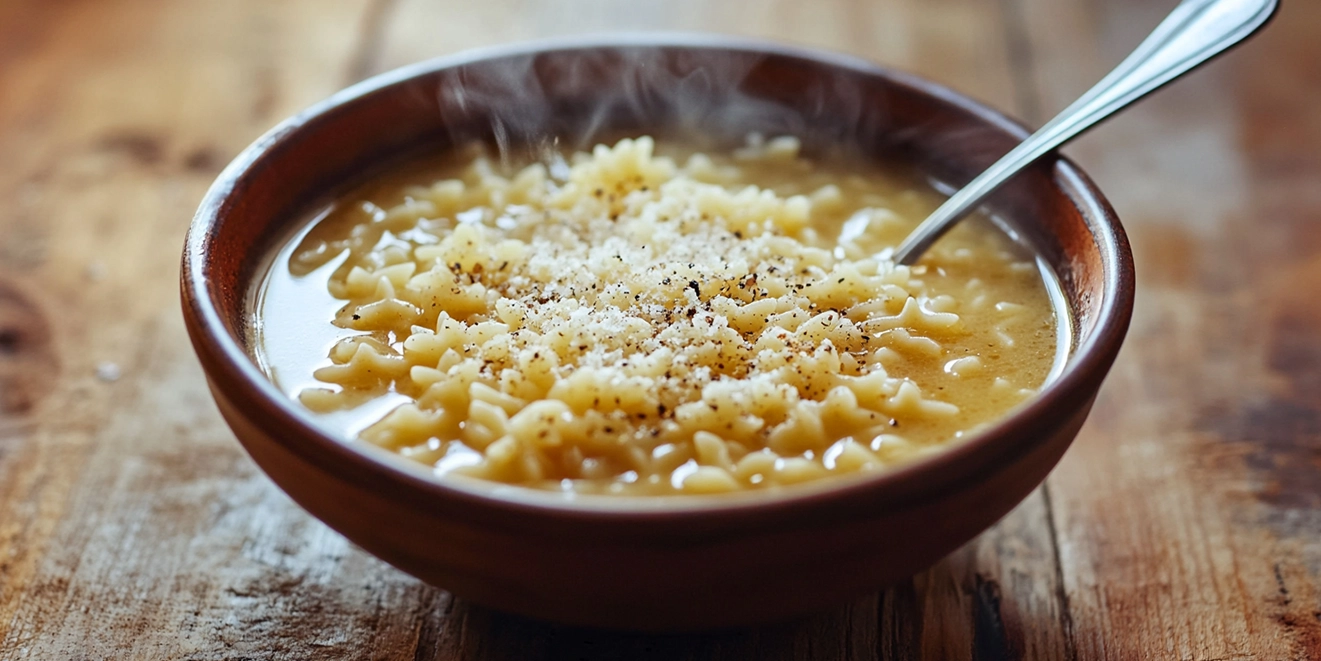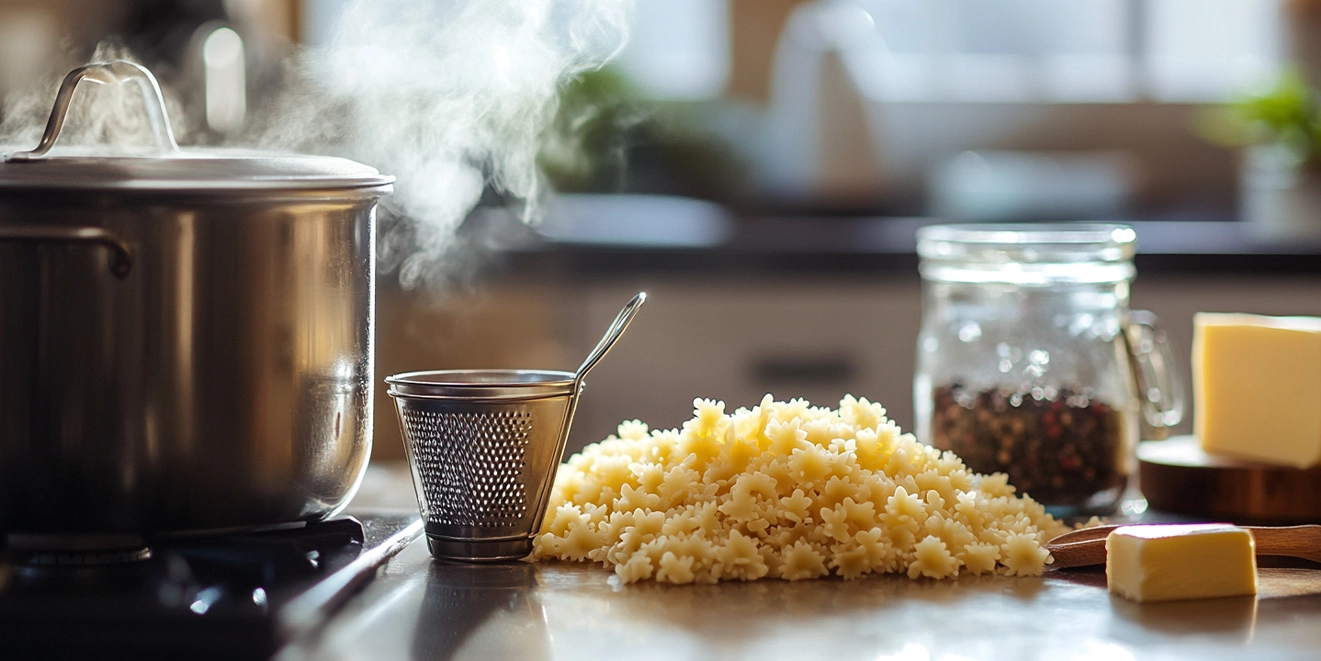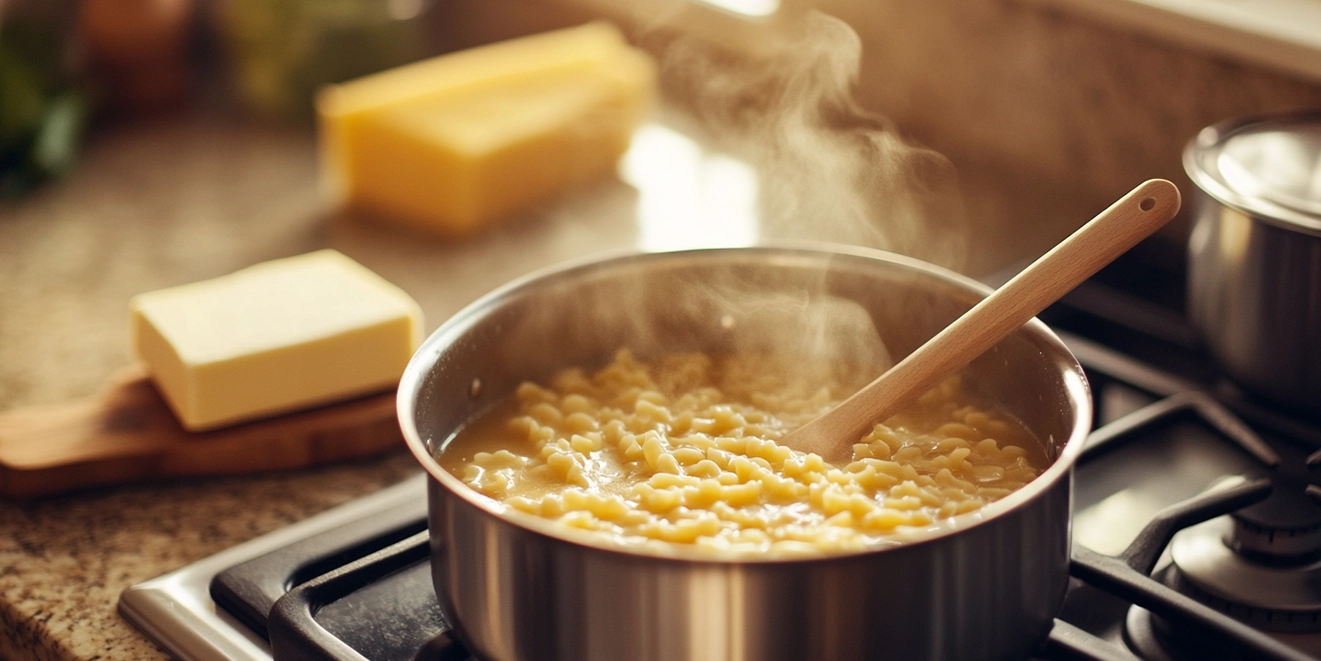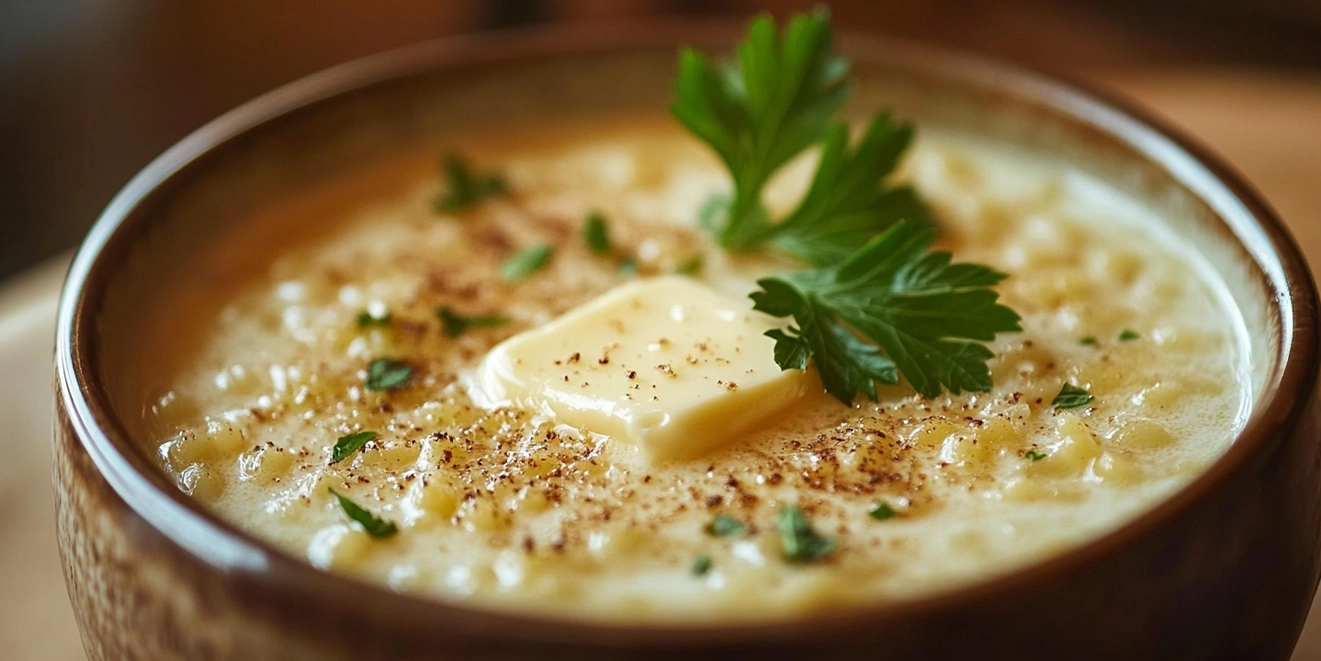
Table of Contents
What is Pastina?
Pastina is the Italian word for “little pasta.” It refers to tiny pasta shapes, often smaller than a grain of rice, commonly used in soups and simple dishes. Pastina is beloved for its versatility and ease of preparation, making it a staple in many households, especially for comforting meals.
Definition and Origins of Pastina
Pastina is pasta in various small shapes, such as stars, grains, or tiny tubes. The name itself derives from the Italian words pasta (paste or dough) and -ina (a diminutive suffix), literally meaning “little pasta.” Its origins can be traced back to Italy, where pasta-making traditions have always celebrated a diversity of shapes and sizes. Pastina was historically crafted to create nourishing, easy-to-digest meals, often for children or older people.
Types of Pastina Commonly Available
Some popular varieties of pasta include:
- Stelline (Little Stars): Star-shaped patina, a favorite for soups.
- Acini di Pepe (Peppercorns): Resembling tiny beads, perfect for broths.
- Orzo: Although slightly more prominent, this rice-shaped pasta is often categorized as patina.
- Risi (Rice-shaped): Similar to orzo but smaller.
- Video: Thin, short-cut noodles, often used in soups.
Due to their small size, these shapes are sold dried and cooked quickly, making them ideal for fast, comforting meals.
Cultural Significance in Italian Cuisine
Pastina holds a special place in Italian cuisine, often associated with feelings of nostalgia and comfort. It is a quintessential “comfort food” in Italian households, frequently served:
- To Children: As an introductory food due to its soft texture and simplicity.
- In Broths: Often combined with chicken broth, butter, or Parmesan cheese for a warming dish.
- For Wellness: Regarded as a soothing meal for those feeling under the weather.
In Italian culture, patina is more than just food; it represents familial love and care. Preparing pasta is often a nurturing gesture, symbolizing the simplicity and warmth of home-cooked meals.
Health Benefits of Pastina
Pastina is a simple, versatile food with several health benefits, particularly for children, older people, and anyone seeking comfort and nourishment. While it is not inherently nutrient-dense, its potential to be enriched with other ingredients makes it a valuable part of a balanced diet.
Nutritional Value of Pastina
Pastina is typically made from semolina flour derived from durum wheat. Here are some key points about its nutritional profile:
- Carbohydrates: A primary source of energy.
- Protein: Moderate levels of plant-based protein.
- Low-Fat Content: Naturally low in fat, making it light and easy to digest.
- Fortified Options: Some patina products contain vitamins and minerals like iron and folic acid.
While plain patina offers basic sustenance, combining it with nutrient-rich ingredients such as vegetables, lean proteins, and healthy fats enhances its nutritional value.
Benefits for Children and the Elderly
- For Children:
- Easy to Digest: Its small size and soft texture make it gentle on developing digestive systems.
- Comfort Food: A soothing option for picky eaters or children recovering from illness.
- Nutrient Versatility: Can be easily paired with milk, broth, or pureed vegetables for added nutrition.
- For the Elderly:
- Gentle on Digestion: Ideal for aging individuals with reduced digestive efficiency or dental issues.
- Customizable: Can be enriched with nutrient-dense ingredients to support dietary needs.
- Hydration Support: Often served in broths, aiding in hydration and warmth.
Pastina in a Balanced Diet
Although patina is predominantly a source of carbohydrates, it can contribute to a balanced diet when paired thoughtfully with other food groups:
- With Proteins: Add eggs, cheese, or lean meats like chicken for protein.
- Vegetables: Include spinach, carrots, peas, or tomatoes to provide fiber and vitamins.
- With Healthy Fats: Incorporate olive oil or avocado for essential fats.
Ingredients for a Classic Recipe

Pastina is a simple yet comforting dish, often enjoyed in its most basic form or enhanced with flavorful additions. Below is an outline of the essential components of a traditional recipe, along with optional enhancements and substitutions to cater to various dietary preferences.
Core Ingredients for a Traditional Pastina Recipe
- Pastina: The dish’s star, usually in shapes like stelline (stars) or acini di pepe (tiny beads).
- Broth or Water: Chicken broth, vegetable stock, or plain water serves as the base for cooking pasta.
- Butter or Olive Oil: Adds richness and a silky texture.
- Parmesan Cheese: For a savory, umami flavor.
Optional Additions to Enhance Flavor
- Proteins:
- Scrambled or poached eggs for added protein.
- Shredded chicken or turkey for heartier meals.
- Soft tofu for a plant-based option.
- Vegetables:
- Carrots, peas, or spinach for added color and nutrition.
- Diced zucchini or tomatoes for a fresh, light taste.
- Herbs and Spices:
- Fresh parsley, basil, or thyme for a fragrant touch.
- A pinch of nutmeg or black pepper for subtle warmth.
- Healthy Fats:
- A drizzle of truffle oil for luxury.
- A dollop of mascarpone or cream for extra richness.
Substitutions for Dietary Preferences
- For Gluten-Free Diets:
- Use gluten-free pasta made from rice, corn, or quinoa.
- For Dairy-Free or Vegan Diets:
- Replace butter with vegan margarine or olive oil.
- Swap Parmesan cheese for nutritional yeast or a dairy-free cheese alternative.
- For Low-Sodium Diets:
- Use homemade or low-sodium broth.
- Limit added cheese and season with herbs instead.
- For High-Protein Options:
- Use lentil or chickpea-based patina.
- Add lean meats or plant-based proteins.
Cooking Tools You’ll Need
Preparing pastina is straightforward and requires only a few essential kitchen tools. However, a few additional tools can refine the culinary process for those looking to elevate the dish with advanced techniques.
Essential Kitchen Tools for Making Pastina
- Pot or Saucepan: A medium-sized pot to cook the pastina and ensure even cooking.
- Wooden Spoon or Spatula: For stirring to prevent sticking or clumping.
- Measuring Cups and Spoons: To accurately measure pastina, broth, or water.
- Colander or Fine-Mesh Strainer: Optional but helpful if you drain excess liquid.
- Serving Bowl and Spoon: For plating and enjoying the dish.
Advanced Tools for Refining the Dish
- Non-Stick Saucepan: Ideal for ensuring the pastina doesn’t stick, especially if cooking with milk or cream.
- Microplane or Grater: For freshly grating Parmesan cheese or zesting lemon to enhance flavor.
- Immersion Blender: To blend the broth with added vegetables, creating a creamy base for the pastina.
- Ladle: For portioning out the pastina and broth perfectly.
- Herb Shears: Finely chop fresh herbs like parsley or basil into the dish.
- Fine Sieve: If making homemade broth, strain out impurities and create a smooth liquid.
- Kitchen Scale: For precise measurements, especially when working with specific portions.
Step-by-Step Cooking Guide
Making pastina is simple, but achieving the perfect texture and flavor requires attention to detail. This guide outlines how to prepare the ingredients, provides step-by-step cooking instructions, and highlights common mistakes to avoid.
How to Prepare the Ingredients
- Measure the Pastina: Use about ¼ to ½ cups of dry pastina per serving, depending on the portion size.
- Prepare the Broth or Liquid:
- Use chicken, vegetable, or beef broth for added flavor.
- Water can be used as a base if lighter taste is preferred.
- Warm the liquid in advance to reduce cooking time.
- Optional Additions:
- Grate Parmesan cheese and set it aside.
- Chop vegetables like carrots or spinach into small pieces for faster cooking.
- Prepare any proteins, such as shredded chicken or poached eggs.
Cooking Instructions with Tips for Perfection

- Bring the Liquid to a Boil:
- Use 2-3 cups of broth or water for every ½ cup of pastina.
- Add a pinch of salt if the broth isn’t pre-seasoned.
- Add the Pastina:
- Stir immediately after adding to prevent clumping.
- Lower the heat to medium, maintaining a gentle boil.
- Cook Until Tender:
- Follow the package instructions, usually 5-7 minutes.
- Stir frequently to ensure even cooking and prevent sticking.
- Enhance with Butter or Olive Oil:
- Once the pastina is tender, stir in a pat of butter or olive oil for richness.
- Incorporate Additional Ingredients:
- Add grated Parmesan cheese, cooked vegetables, or proteins.
- Stir in milk, cream, or blended vegetables for a creamy consistency.
- Season and Serve:
- Taste and adjust seasoning with salt, pepper, or fresh herbs like parsley.
- Serve immediately while hot for the best texture.
Why You’ll Love This Recipe
- Comforting and Nostalgic: This dish is perfect for when you need a little extra warmth and care.
- Quick and Easy: Ready in under 15 minutes.
- Kid-Friendly: Its creamy texture makes it a hit with little ones.
For more ideas to inspire your culinary creations, check out our ultimate guide to chicken tenderloin recipes for versatile and hearty meals.
Serving Suggestions
Pastina pairs wonderfully with roasted vegetables or a fresh salad. For a more robust meal, try it alongside our shrimp pasta recipe, which adds a luxurious seafood twist to your table.
Storage and Reheating Tips
Any leftovers can be stored in an airtight container in the refrigerator for up to 3 days. To maintain its creamy consistency, reheat gently on the stovetop with a splash of broth.
For more helpful tips on perfecting pasta dishes, explore how long to cook spaghetti for foolproof preparation.
Common Mistakes to Avoid
- Overcooking the Pastina:
- It cooks quickly and can become mushy if left unattended. Check for doneness frequently.
- Using Too Much or Too Little Liquid:
- Insufficient liquid may cause the pastina to stick, while excess liquid can dilute the flavors.
- Skipping the Stirring:
- Pastina is prone to clumping, so regular stirring is crucial during cooking.
- Underseasoning:
- If using water instead of broth, ensure adequate seasoning to avoid a bland dish.
- Adding Dairy Too Early:
- If incorporating milk or cream, add it after the pastina has cooked to prevent curdling.
Variations of Pastina Recipes
Pastina is a versatile dish that can be customized to suit different tastes and dietary preferences. Below are three popular variations: creamy pastina with cheese and butter, broth-based pastina soup, and vegan and gluten-free alternatives.
- Creamy Pastina with Cheese and Butter
A comforting, indulgent version that’s perfect as a quick meal or side dish.
Ingredients:
- ½ cup pastina
- 2 cups water or milk (or a mix of both)
- 1 tbsp butter
- 2 tbsp grated Parmesan cheese (or more, to taste)
- Salt and pepper to taste
Instructions:
- Cook the pastina in water or milk until tender, stirring frequently.
- Drain excess liquid, leaving a small amount for creaminess.
- Stir in butter and Parmesan cheese until melted and thoroughly combined.
- Season with salt and pepper, and serve warm.
Tip: Add a sprinkle of nutmeg or a dash of cream for extra richness.
- Broth-Based Pastina Soup
It is a light and soothing option, ideal for a simple lunch or when feeling under the weather.
Ingredients:
- ½ cup pastina
- 3 cups chicken or vegetable broth
- One small carrot, diced
- One celery stalk, diced
- Optional: shredded chicken or cooked egg
- Fresh parsley for garnish
Instructions:
- Bring the broth to a boil and add the diced carrot and celery. Cook for 5 minutes.
- Add the pastina and cook until tender, stirring occasionally.
- Optional: Stir in shredded chicken or add a poached egg for protein.
- Garnish with fresh parsley and serve hot.
Tip: For a richer flavor, sauté the vegetables in olive oil before adding them to the broth.
- Vegan and Gluten-Free Alternatives
A plant-based and allergen-friendly version that doesn’t compromise on flavor.
Ingredients:
- ½ cup gluten-free pastina (made from quinoa, rice, or lentils)
- 2 cups vegetable broth
- 1 tbsp olive oil or vegan butter
- 2 tbsp nutritional yeast (for a cheesy flavor)
- Salt, pepper, and fresh herbs to taste
Instructions:
- Cook the gluten-free pastina in vegetable broth until tender.
- Stir in olive oil or vegan butter for richness.
- Add nutritional yeast for a savory, cheesy taste.
- Season with salt, pepper, and fresh herbs, and serve immediately.
Tip: Mix roasted vegetables like zucchini or bell peppers for added texture and flavor.
Serving Suggestions

Pasta is a versatile dish that can be paired with various accompaniments and presented beautifully. Here are some ideal pairings and creative plating ideas to enhance your pasta meal.
Ideal Accompaniments for Pastina
- For Creamy Pastina with Cheese and Butter:
- Salads: A crisp green salad with a tangy vinaigrette balances the dish’s richness.
- Vegetables: Roasted or steamed vegetables like broccoli, carrots, or zucchini add color and nutrition.
- Proteins: Serve alongside grilled chicken, fish, or turkey for a complete meal.
- For Broth-Based Pastina Soup:
- Crusty Bread: Warm, crusty bread or garlic toast complements the light, brothy texture.
- Light Appetizers: Pair with a simple antipasto platter of olives, cured meats, and cheese.
- Side Vegetables: A side of sautéed greens, such as spinach or kale, adds vibrancy.
- For Vegan and Gluten-Free Pastina:
- Grilled Vegetables: Serve with charred bell peppers, asparagus, or eggplant.
- Legume-Based Proteins: Chickpea fritters or lentil patties make hearty companions.
- Fresh Fruits: A small side of fresh fruit, like citrus slices, provides a refreshing contrast.
Plating Ideas for Presentation
- Bowls for Comfort:
- Serve pastina in deep bowls to emphasize its cozy, comforting nature.
- For a polished finish, garnish with fresh herbs, a drizzle of olive oil, or a sprinkle of Parmesan.
- Layered Presentation:
- For creamy pastina, layer with sautéed vegetables or shredded proteins in a clear glass bowl to showcase the dish’s elements.
- Use colorful garnishes like paprika or chopped parsley to add visual interest.
- Plated Elegance:
- A round mold shapes the pastina into a neat circle on a flat plate.
- Surround with a drizzle of sauce or broth for an elevated, restaurant-quality appearance.
- Rustic Style:
- Present broth-based pastina in a rustic ceramic bowl with a slice of crusty bread on the side.
- Use natural, earthy garnishes like thyme sprigs for a homely feel.
- Kid-Friendly Fun:
- Use cookie cutters to shape vegetables or proteins served with pastina.
- Top with a tiny sprinkle of colorful cheese shreds for added appeal.
Frequently Asked Questions
What is so special about pastina?
Pastina is special in Italian cuisine as a comforting, nostalgic dish often associated with childhood and family traditions. Its tiny size makes it versatile and easy to prepare, especially for soups, creamy dishes, or simple meals for children and older people. The ability to customize it with various flavors, broths, and ingredients adds to its charm, making it a dish loved for both its simplicity and adaptability.
What can I use instead of pastina?
If pastina is unavailable, several alternatives can be used:
- Orzo: Rice-shaped pasta that works well in soups or creamy dishes.
- Couscous: An excellent substitute for texture, especially in broths.
- Acini di Pepe: Slightly more prominent but still a good match for soups.
- Rice: Ideal for gluten-free options or when a grain-based texture is desired.
- Quinoa: A protein-rich, gluten-free substitute.
Does pastina reheat well?
Pastina can be reheated, but its texture may change as it absorbs liquids and becomes softer over time. To reheat:
- Add a broth, water, or milk splash to the pastina before reheating to restore moisture.
- Warm it gently on the stovetop or microwave, stirring occasionally to ensure even heating.
Tip: Avoid overheating, as this can make the pastina mushy.
Why did they stop making pastina?
Some brands have discontinued pastina production due to changes in manufacturing priorities or reduced demand in specific markets. However, many other brands still produce pastina, and alternatives like small pasta shapes (e.g., orzo or acini di pepe) are widely available. For those unable to find pastina, homemade versions can also be crafted by cutting fresh pasta dough into tiny pieces.
Tip: Check specialty Italian markets or online retailers for authentic pastina varieties.
Pairing Pastina with Other Dishes
Pastina is a versatile meal addition, whether used as a central component in soups and stews or as a simple yet satisfying side dish. Here’s how to pair pastina with other dishes for a balanced and flavorful dining experience.
Soups and Stews to Pair with Pastina
- Classic Chicken Soup:
- Pastina enhances chicken soup by adding a hearty texture. The small pasta absorbs the flavors of the broth, creating a comforting and filling dish.
- Vegetable Minestrone:
- For a unique twist, replace traditional larger pasta with pastina. The smaller size ensures that every spoonful is loaded with vegetables, broth, and pasta.
- Italian Wedding Soup:
- Substitute larger pasta shapes with pastina for a more delicate version of this traditional dish. It pairs perfectly with the tender meatballs and spinach.
- Beef or Lamb Stew:
- Serve pastina as a base for rich, slow-cooked stews. The pasta soaks up the savory juices, making each bite flavorful.
- Tomato Soup:
- Stir cooked pastina directly into creamy tomato soup for added texture and substance, turning a simple soup into a hearty meal.
Pastina as a Side Dish
- With Grilled or Roasted Proteins:
- Pair creamy pastina with grilled chicken, roasted fish, or baked tofu for a balanced plate. The soft texture complements the crispy, savory main dish.
- Alongside Vegetables:
- Serve pastina as a base for roasted or sautéed vegetables, such as zucchini, bell peppers, or asparagus. A drizzle of olive oil ties the flavors together.
- As a Substitute for Risotto:
- Prepare pastina in a creamy style with butter and Parmesan, serving it as a quick and easy alternative to risotto alongside meats or salads.
- With Braised Dishes:
- Pastina pairs beautifully with braised dishes like short ribs or pork chops. The pasta absorbs the braising liquids, adding depth to the side dish.
- With Breakfast Proteins:
- Serve pastina as a savory breakfast side with scrambled eggs, breakfast sausages, or a poached egg on top for a comforting start to the day.
Conclusion
Pastina is more than just a pasta type; it symbolizes comfort, tradition, and versatility in Italian cuisine. Whether served as a creamy main dish, a soothing soup, or a simple side, its adaptability makes it a favorite for all ages. From its rich history and cultural significance to the wide variety of recipes it inspires, pastina remains a cherished staple in kitchens worldwide.
Pastina’s ability to pair with diverse ingredients and accommodate dietary preferences ensures everyone can enjoy its charm. Whether you’re preparing a hearty broth-based dish, a vegan-friendly alternative, or a classic creamy recipe, pastina always delivers a sense of home and nourishment.
- Feeling creative? Learn how to add a twist to your recipes by exploring creative ways to make baked beans for complementary side dishes.
- Looking to elevate your dish? Consider pairing it with the flavors of chicken broth for an even more savory base.
